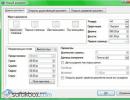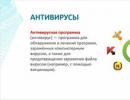Presentations on computer science. Computer science
The computer science presentation talks about computer viruses: definition of a computer virus; history of the creation of computer viruses; classification of computer viruses by habitat; classification of viruses according to destructive capabilities; distinctive features of viruses; ways of viruses to penetrate and signs of computer infection; antivirus programs.

The development contains a training program created in MS Power Point and an instruction card for working with the program. Working with presentations is quite simple, you only use the mouse, but you must perform the actions according to the attached instructions. There is a hint in the presentation - the mouse pointer turns into a palm if it is pointed at the correct element of the slide. The attached instructions contain not only the procedure for performing the actions, but also theoretical material for study and memorization. The presentation starts in demo mode, but you can exit it by pressing the "Esc" key.


Target audience: for 11th grade
Currently, there are a huge number of sites on the Internet, so there is a need to somehow classify them. This can be done in various ways, using different signs. Sites can be classified by affiliation, media type, status, type, etc.


The presentation was developed to accompany an 8th grade lesson on the topic Programming branching algorithms. The presentation is designed for 2 lessons: introduction to the branch operator, solving problems using the branch operator. The presentation uses problems from Bosova's textbook Informatics, grade 8.


Target audience: for teachers
Presentation on computer science, which can be used in grades 8-9 when studying algorithms and performers. The presentation is dedicated to the “Robot” performer, which is used in solving algorithmic problems.
Performer Robot is used to solve task 20.1 of the Main State Exam in 9th grade. The presentation will be useful both for lessons and for consultations in preparation for the OGE in computer science.
It gives the basic concepts and commands that are used by the Robot, analyzes in detail simple tasks for executing algorithms using the Robot and tasks from the OGE in computer science in 9th grade.


This presentation can be used for 1-2 lessons on the topic “Algorithm. Executors of the algorithm”, both on-site and remotely, as well as in preparing students for the OGE in computer science.
The presentation of the material is divided into sections:
- "The concept of an algorithm"
- "Algorithm Executor"
- "Algorithm Properties"
- Problems on the topic “Algorithms and Executors” (OGE)
- Independent work (two options)


Target audience: for 9th grade
This presentation is part of the Computer Science Educational Course. It is a multimedia accompaniment to the topic "Ethics of Network Communication". This topic is discussed according to the textbook by N.V. Makarova in the 10th grade. Can be used both by a teacher in a lesson and for independent study.


Target audience: for 10th grade
Presentation on the topic "Man and Information" for the lesson "Information Processes" for 7th grade.
The slides discuss issues of a new topic (information processes, information activities, information transfer scheme, information transfer speed, system of units).
To repeat and summarize educational material, students answer questions in an interactive crossword puzzle. The crossword puzzle is easy to use and can be solved from any word. When you click on a number horizontally or vertically, the text of the question appears (! Be sure to click only when the pointer appears), when you click on the text block, the answer will appear in the cells of the field, when you click on the text block a second time, it will disappear. At the end of the presentation, a step-by-step solution to the problems is presented.


Presentation on computer science for 7th grade.
Suitable for use when studying the topic “Basic concepts of computer graphics” according to the textbook by A.V. Goryachev.
Images made up of pixels are called raster images. This type of computer graphics is called raster graphics. To create images on a computer, computer application programs called graphic editors are used.


Target audience: for 7th grade
https://accounts.google.com
Slide captions:
Preview:
To use presentation previews, create a Google account and log in to it: https://accounts.google.com
Slide captions:
Programming languages
A programming language is a formal sign system designed to write computer programs. A programming language defines a set of lexical and syntactic rules that define the appearance of a program.
1960 - creation of the Cobol language 1960 Peter Naur created the Algol programming language. 1963 - creation of the BASIC language 1964 - IBM Corporation created the PL/1 language 1968 - a new version of the Algol language.
In 1969, the SETL language was created - a language for describing operations on sets. The main data structure in the language is a set, and the operations are similar to mathematical operations on sets. Perl is a language created to help the system administrator of the Unix operating system to process various types of texts and highlight the necessary information. It has developed into a powerful tool for working with texts. Python is an interpreted, object-oriented programming language. It is close in structure and scope to Perl, but is less widespread and more strict and logical.
The first universal languages The first programs were written in machine language. Programmers were required to know the machine architecture thoroughly. The programs were quite simple, which was due to the very limited capabilities of these machines, and the great complexity of developing and, most importantly, debugging programs directly in machine language. At the same time, this method of development gave the programmer incredible power over the system. It became possible to use clever algorithms and ways of organizing programs. For example, a feature such as self-modifying code could be used. Knowledge of the binary representation of commands sometimes made it possible not to store some data separately, but to embed them in the code as commands.
The first significant step seems to be the transition to assembly language. The programmer no longer had to delve into how to encode commands at the hardware level. It also became possible to use macros and labels, which also simplified the creation, modification and debugging of programs.
Assembler At the same time, the transition to a new language also contained some negative aspects. The capabilities of programmers have been greatly reduced. In addition, here, for the first time in the history of programming development, two representations of the program appeared: in source texts and in compiled form. By the end of the assembler era, the possibility of automatic translation in both directions was lost. In this regard, a large number of special disassembler programs have been developed that perform inverse transformations, but in most cases they can hardly separate code and data.
FORTRAN The next step was taken in 1954, when the first high-level language, Fortran, was created. For the first time, a programmer could truly abstract himself from the peculiarities of machine architecture. The syntactic structure of the language was quite complex for machine processing, primarily due to the fact that spaces were not used at all as syntactic units. This gave rise to a lot of opportunities for hidden errors, such as, for example: In Fortran, the construction: “DO 10 I=1,100” describes “the cycle of executing an operator when the index changes from 1 to 100.” If you replace the comma here with a dot, you get the assignment operator: DO10I = 1.100.
FORTRAN The Fortran language was used for scientific computing. It suffers from the absence of many familiar language constructs and attributes; the compiler practically does not check the syntactically correct program in terms of correctness. According to Backus himself, they were faced with the task of developing a compiler rather than a language. Understanding the independent significance of programming languages came later.
FORTRAN The introduction of Fortran was met with even more fierce criticism than the introduction of assembler. After some time, the understanding came that the implementation of large projects is impossible without the use of high-level languages. The power of computers grew, and the decline in efficiency, which was previously considered threatening, became possible to come to terms with. The advantages of high-level languages became so obvious that they prompted developers to create new languages, more and more advanced.
Pascal-like languages In 1970, Niklaus Wirth created the Pascal programming language. The language is remarkable in that it is the first widely used structured programming language. This language also introduced strict type checking, which made it possible to identify many errors at the compilation stage.
C and similar languages In 1972, Kernighan and Ritchie created the C programming language. 14 years later, Bjarne Stroustrup created the first version of the C++ language, adding object-oriented features to the C language. The language has become the basis for the development of modern large and complex projects. In 1999–2000, Microsoft created the C# language. It is quite similar to Java (and was intended as an alternative to the latter), but it also has distinctive features. Focused mainly on the development of multi-component Internet applications.
Thank you for your attention!)
Preview:
To use presentation previews, create a Google account and log in to it: https://accounts.google.com
Slide captions:
Preview:
To use presentation previews, create a Google account and log in to it: https://accounts.google.com
Slide captions:
Preview:
To use presentation previews, create a Google account and log in to it: https://accounts.google.com
Slide captions:
Preview:
To use presentation previews, create a Google account and log in to it: https://accounts.google.com
Slide captions:
Information Security
We live in an age of explosive development of information technology. Virtualization, the growth in the number of social networks have led to the “stuffing” of a large amount of personal data online, “cloud computing” - all this has given new impetus to the development of the field of information security.
Main goals and objectives of information security. Secrecy Integrity Identification Authentication Authorization Access Control Certification Non-repudiation Dating Revocation Witnessing Anonymity
Information threats and how they manifest themselves. The source of the threat is potential man-made, man-made or natural sources of security threats.
"Trojan" or Trojan horse (troj); - worm; - spy or spy, - rootkick; - bot or zombie.
Well-known computer worms of the IM-Worm type have a common method of self-propagation - sending messages containing a URL to a file located on some web server to detected entries in the contact list of an Internet pager. This technique almost completely replicates one of the self-mailing methods used by email worms.
Trojan or “Trojan horse” An example of Trojan infection - you receive a letter from a certain “friend” with the text: - “Hello! I just returned from the sea - I had such a great time! Here are my photos - look.”, and attached files with the extension “.JPG”. These very files are a Trojan horse in the depths of which malicious code is hidden. The most common sources of infection are email, dating sites, music sites, and free software sites. What does Trojan do? As a rule, its task is to open the way for other viruses, to act as the first springboard.
bot or zombie. It allows attackers to remotely and secretly control infected machines. Moreover, you can manage each infected PC individually, a group of them, and the entire network. It is clear that the user of an infected computer (“bot”) has no idea that his PC is being used by cybercriminals. For this reason, infected computers are also called “zombies”, and the network they are part of is called a zombie network.
Spy or spy These programs are designed to spy on the user. These are primarily keyloggers, all kinds of systems for tracking user activity. An interesting feature of many programs in this category is that they are often quite legally distributed and sold, equipped with detailed documentation and an installer. However, the tasks they solve (secretly collecting information, secretly sending collected information in accordance with the settings leave no doubt about the harmfulness of these programs).
rootkick So, a rootkit is a program (set of programs) for hiding traces of the presence of an attacker or malicious code in the operating system. By installing a rootkit on your computer, a hacker gains full control over it, can remotely control the computer and download other malicious programs onto it.
Methods of protecting information from information threats. To protect your computer from infection by viruses and other types of malware, of course, you need to install anti-virus software.
An antivirus program is a computer program whose purpose is to detect, prevent and remove computer viruses and other malicious programs. Many antivirus programs not only detect, but also prevent unauthorized entry of malware into your computer.
Top 5 most reliable antivirus programs During tests, antiviruses were compared according to 5 indicators: speed of individual operations; user learning speed; number of mistakes; visual appeal of the interface; subjective user satisfaction
From what has been discussed, it becomes obvious that ensuring information security is a complex task. This is due to the fact that the information environment is a complex multifaceted mechanism in which components such as electronic equipment, software, and personnel operate.
To solve the problem of ensuring information security, it is necessary to use legislative, organizational and software and technical measures. Neglecting at least one aspect of this problem can lead to the loss or leakage of information, the cost and role of which in the life of modern society is becoming increasingly important.
The emergence of computer science The introduction of computer technology into all spheres of human activity gave rise to the emergence of a new scientific and applied discipline - computer science. This term was first used in France in the 60s. In English-speaking countries, it corresponds to the synonym computer science (the science of computer technology). In our country, computer science began to be defined as an independent field of activity from the early 80s, and a few years later it entered the school curriculum as an independent discipline.
Informatics is a set of scientific fields that study information, information processes in nature, society, technology, formalization and modeling as methods of cognition, methods of representing, accumulating, processing and transmitting information using technical means, and much more.

The term "informatics" (French informatique) comes from the French words information (information) and automatique (automation) and literally means "information automation". Informatique = information + automatique Informatics = information + automation The term "informatics"



The main features of the information society are the possibility of access for any member of society almost anywhere in the territory at an acceptable time to the information he needs (with the exception of state secrets) information is the most important strategic resource of society and occupies a key place in the economy, education, culture of the majority of workers (about 80 %) employed in the information sector, that is, the sphere of information production and information services

To characterize the information support of historical eras, the following parameters are distinguished: organization of information transfer in SPACE (that is, the dissemination of information between remote people in a relatively short time interval) organization of information transfer in TIME (that is, accumulation and storage of information) organization of information PROCESSING, that is, its transformation with the purpose of use for practical purposes - management, education, creation of new information (science)


Human culture is determined by: 1. Knowledge, abilities, professional skills. 2. The level of intellectual, aesthetic and moral development 3. The methods and forms of mutual communication Personal culture of a person: 1. The level of his mental development 2. The nature of his professional and creative activity Information culture is the ability to purposefully work with information and use it to receive and process it and transfer of computer information technology, modern technical means and methods. -Use various technical devices from a computer to computer networks -Ability to master information technology -Ability to extract information both from periodicals and from electronic communications -Ability to present information in an understandable form and use it correctly with maximum effect -Knowledge of various methods of information processing -Ability to work with different types of information

Thus, at present, computer science (like medicine) can be considered as a complex discipline: firstly, it is a natural science (fundamental and applied research); secondly, the industry sector (development and production); thirdly, the infrastructure area (professional activities and operation of information systems).

As an infrastructural field, computer science deals with the service and operation of information systems, training, etc. Computer science As a natural science, computer science studies the general properties of information (data and knowledge), methods and systems for its creation, accumulation, processing, storage, transmission and distribution using computing tools technology and communications. As a branch of industry, computer science deals with the design, manufacture, marketing and development of information systems and their components.

Correct working posture You should sit upright (not slouching) and lean your back against the back of the chair. You need to bend your back in the lumbar region not back, but, on the contrary, slightly in front. It is unacceptable to work while lounging in a chair. This position causes rapid fatigue and decreased performance. You should not raise your wrists high or bend your hands - this can cause pain in your hands and numbness in your fingers. Knees - at hip level or slightly lower. With this position of the legs, muscle tension does not occur. You cannot cross your legs or cross your legs - this disrupts blood circulation due to compression of blood vessels. It is better to keep both feet on a stand or floor. It is necessary to maintain a right angle (90 0) in the area of the elbow, hip and ankle joints.

Correct working posture The monitor must be installed at such a height that the center of the screen is cm below eye level, the angle of inclination is up to The monitor screen should be at an optimal distance from the user's eyes, cm, but not closer than 50 cm, taking into account the size of alphanumeric characters and symbols. Do not place shiny or reflective objects near the monitor. The screen surface must be clean and free of light reflections.






